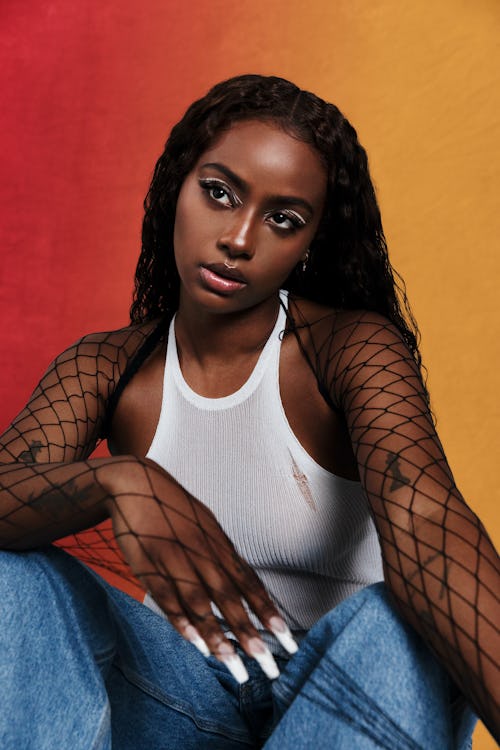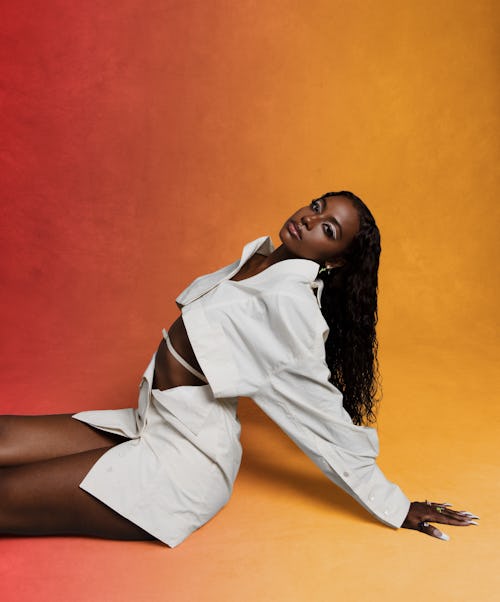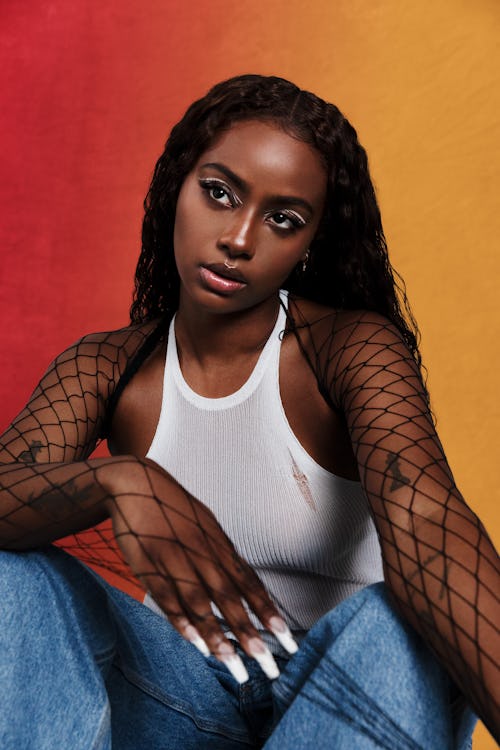
Justine Skye leans forward, palm on her chin, carefully listening to astrologer Dayna Lynn Nuckolls on a Zoom call from New Orleans, a city known for its spiritual magnitude. Justine’s mink lashes flutter as she blinks and nods. Her auburn ponytails brush her shoulder blades. She’s wearing a white one-shoulder shirt and baggy cargo jeans. Born Justine Skyers on August 24, 1995, the singer is getting her birth chart read for the first time.
Justine is not easily swayed by astrology. “I’m chillin’,” she says when Dayna asks if she’s nervous or excited before the reading. Instead, the 26-year-old artist is contemplative. We find out her rising sign is in Scorpio (Virgo sun, Leo moon), a sign known for sitting back and sharing very little. It’s a sign that’s also often misunderstood. “Sometimes I can be open, and I feel like I have in the past,” Justine tells the astrologer. “But it’s come back to bite me in the ass.”
Her reticence comes from experience. Justine’s had a healthy dose of fame, having been in the spotlight since her teens. She began her popular Tumblr account in 2011, and it’s been difficult for Justine to break away from the persona she shaped during this time on social media. Nearly a decade into her career, she’s wrestling with sharing who she is in this moment — defined so many years ago by an audience used to knowing every detail of her life.
“You are a force,” Dayna tells her. “People don’t see or recognize who you really are.”

Justine Skye is an artist who intimately understands how it feels to possess an online persona. It’s not because she’s had to try, but because people are attracted to her, what she represents, and where she comes from.
Widely known as the girl who made a name for herself on Tumblr, Justine was born in Brooklyn, a cultural mecca where Black teens often birth dance, fashion, and music trends. Justine was raised mainly by her mother, entertainment lawyer Nova Perry, and the other women of her family. The world was at her fingertips. In Brooklyn, even if you don’t have access to all the city has to offer, you have close proximity — and your life will look amazing online.
Those who found Justine on Tumblr were attracted to her adventures around New York City, her curly, deep purple hair, and her makeup skills. She’d post about her boyfriends or daily outings with her friend group. They’d host meetups in the city and hangouts with those who followed them on Tumblr.
In the 2010s, Tumblr was home for pop-punk music and the further shaping of an emo aesthetic that began on MySpace the decade before. While “emo” can reference a particular style and a look — black nail polish, dark hair, and feelings — it took on a broader term on Tumblr. The platform had a reputation as an underground spot where you could find other people you could relate to and be your most vulnerable self.
“Sometimes I can be open, and I feel like I have in the past. But it’s come back to bite me in the ass.”
Justine wasn’t exactly emo in the sense that she belonged to the emo community, but she was part of a relatable Black friend group making music and art. She listened to and often quoted or reblogged artists who grew their following on Tumblr, like A$AP Mob, Odd Future, and Frank Ocean. I discovered these same artists the same way I found Justine, through reblogs and Soundcloud link embeds. Tumblr was where you found music that wasn’t yet on the radio. That element of discovery made the music even sweeter.
Justine became a highly visible dark-skinned Black girl on the platform through hundreds of thousands of reblogs. She was a source of beauty inspiration for a high school generation in the early 2010s; there were few celebrated images of dark skin Black teenage girls across TV, film, billboards, marketing campaigns. Her makeup, even a minimal ruby red lip, was always on point, and her deep purple highlights were her identifier; it was easy to spot Justine when she popped up on your feed.
Her Tumblr posts were short and wistful. They never felt like she spent a lot of time painstakingly writing them, but they always had a sense of “this is who I am.” She’d do tons of Q&As, respond to critiques of her music, and send thank yous to fans. Justine’s personality really came out when she was talking to her fans. She was resistant about cozying up to popular images she didn’t relate to, and she often expressed this when fans would say she reminded them of other artists. “I am incomparable to Beyoncé and whoever else people are trying to compare me to because that’s what people do when a new artist comes...They compare, compare, compare…” Justine has never had to be that. “I don’t want to be like anyone else other than who I am.”
Slowly, her singing career blossomed. Justine started with covers that displayed her vocal range, like ‘Diamond” by Rihanna or by remixing “Highline” by Drakes. “I became obsessed with the process of recording songs, tracking my vocals, adding background vocals, seeing what I could do with my voice,” she tells me. But Justine’s vocals have always remained her greatest strength, carrying a track with melody and strength rather than depending on a hot beat.

In 2013, a thrilled 18-year-old Justine appeared on BET’s 106 & Park hosted by Lil’ Bow Wow and Keshia Chante to debut her first EP signed to Atlantic Records, Everyday Living. Listening to this first EP now is a reminder that Justine’s music often contains futuristic-sounding production elements. Emotionally Unavailable, released in 2015, was her last Tumblr album in a sense it was the last music she heavily promoted there. It departed from Everyday Living with more stripped-down vocals, piano melodies, guitar strums, and voice note interludes. Three years later, she left the label to sign with Roc Nation, where she created her first album, Ultraviolet.
More and more, the music industry requires artists to be their own social media strategists —it’s almost impossible to survive if you’re not. Nostalgia for Justine’s early online presence seems to stick with her fans. But gradually, it felt like fans were hearing less from her directly. Justine spent her time out and about while making music, attending industry events with friends like Hailey Bieber, Kendall Jenner, and Jaden Smith. Justine’s talent has often been smoke-screened by who she’s seen with or dating.
From a fan perspective, the deeper Justine journeyed into the music business, the more she became detached from her personality. Justine aspires to make art and write songs that are a total reflection of herself. Still, media coverage surrounding who she is seen with, and her past romantic partners, has clouded her reputation as an artist with a point of view.
Justine partly believes this is what the internet now demands of new artists who want to break through. “I was sharing so much when I first started, and then as I became an artist, and the internet started to take more of a form, I held back. In the beginning, I guess it helped, but it hindered as well. I’m like, ‘I don’t know how to maneuver this anymore because I don’t want to share every part of me.’”
Tumblr was where you found music that wasn’t yet on the radio. That element of discovery made the music even sweeter.
Being signed to record labels didn’t help. Songs arrived at her doorstep with the note this could be for you. Justine was asked to relate to lyrics she had no real connection with. But then, music production duo Leon Thomas III and Khristopher Riddick-Tynes, known as The Rascals, started getting to know Justine. They brought her “Build,” about the desire to construct the perfect man after meeting all the wrong ones.
At the time Justine recorded the song, she hadn’t been physically abused by her then-boyfriend. But when she was ready to film the music video, the song took on a different meaning. She needed to share her story of physical abuse; it wasn’t something she could keep to herself.
Justine was hesitant to name names, mostly because she doesn’t feel anyone would care; survivors of domestic abuse are ostracized or ignored by both their communities and by the police. She eventually tweeted a video naming rapper Sheck Wes as the abuser and dedicated the “Build” video featuring Arin Ray to the fight against domestic violence.
“There was a situation going on that brought more attention to the song,” Justine tells me. “But I think it was more me being the most candid that I’ve ever been, tapping into a situation that I’ve been through.”
With her latest release, Space + Time, her third studio album in as many years, Justine aims to reframe who she is for her audience. On the cover, she leans back and focuses a security camera onto herself. Justine tells me that Space + Time is just the beginning. But the beginning of what, exactly? “I don’t think I’ve had a true opportunity to start fresh,” she says.

Fans and observers today allude to Justine having lost her individuality and willingness to speak out. But regaining a sense of self in your twenties when you were so influential on the internet as a teenager can be an alienating challenge.
Quarantine led Justine to reexamine her online presence. Her tour for her second album, Bare With Me, was canceled, and she was stuck at home in Los Angeles. She began hosting Wine Wednesday chats on Instagram Live, breezy conversations that were reminiscent of how she used to connect with fans on Tumblr. Joined by friends, she’d answer questions about love and relationships and talk through “what if” scenarios involving shoddy men. But she avoided oversharing about her personal life. “In some ways, I can get lost in trying to figure out how much to share how I want to share,” she tells me.
Instagram is where Space + Time was born. Like Justine, Timbaland was also having a productive quarantine, starting the music battle series Verzuz with producer Swizz Beatz. When he saw Justine post a video of herself singing a cover of Crosby, Stills, and Nash’s “Helplessly Hoping,” with DJ Simi Khadra on guitar, he sent her a DM. Timbaland was eager to pair Justine’s vocals with one of his beats. This became a video series titled “Space + Time” ‘that both Justine and Timbaland uploaded to their accounts.
More and more, the music industry requires artists to be their own social media strategists. It’s almost impossible to survive if you’re not.
The circumstances of 2020 led to a tight-knit group putting together the album, including Emily Pires and Elena Hristu of E&E Creative, Justine’s managers and creative directors, and Justin Timberlake, who appears on “Innocent.” Space + Time is a project in which everyone involved is invested in Justine the artist, not just the mechanics of her career. “When you want to create a project that resonates for you and represents you as an artist,” she says, “you have to find the core people who can help you create and curate your sound.”
The album crosses genres, from Afrobeats to R&B to pop, all with a futuristic-sounding production synonymous with Timbaland. It’s a project where Justine appears to be regaining confidence as a writer in the process of grappling with self-doubt, or romantic loss, or mostly, feeling in control in the game of love. Space + Time opens with “Conscious,” a flowy intro leading to “About Time.” It feels like she is talking to old lovers and old friends she realized she couldn’t trust. “There’s a lot I won’t say / Don’t wanna just react / Facts, this time I won’t relapse / Knew that none of y’all had my back.” On “Twisted Fantasy” featuring Nigerian artist Rema, Justine is at her brightest, and she’s forthright; she will move on quickly if she finds that she can’t trust you. But, if you treat her right, she might let you stay in her presence.
“I just want to be known for the music,” says Justine in the opening scene of a documentary about the making of Space + Time, which tracks the journey from Justine’s first session with Timbaland, to traveling to Miami to record in a new environment, to playing the album for her close friends back in LA, including DJ Simi Khadra. “You have no idea what it’s like to have been signed to two labels, and not accomplish the things I’ve wanted to,” she says in a voiceover.
Space + Time is definitely the beginning of the next phase of Justine’s career — and her life. It may not be the breakout album that catapults her to the top of the streaming charts, but it’s a solid new foundation, one she can build from as an independent artist. “You are a teacher,” Nuckolls says toward the end of the astrology reading. I can tell Justine is a little more open and loosened up now, and she’s really listening. “This is something I’ve known about myself,” Justine responds. “But I haven’t fully tapped into it yet.”

Photographer: Kajal
Stylist: Ryan Davis
Hair: Theo Barrett
Makeup: Deneka Maile
Executive Producer: Shanté Cosme
Lighting Director: David Jaffe
DIT: Michael O’Donoghue
Production Assistant: Giselle Sanchez
Talent Booker: Dan Resnick







